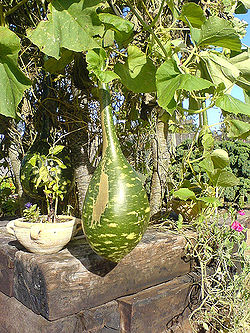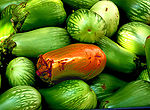Gourd
| Gourd |
|---|

|
| Scientific Classification |
|
| Species |
|
Gourds are fruits that are in the same family as pumpkins and squash. Gourds come in a variety of colors, shapes, and sizes. Gourds can be found in a warm area where water is available, many gourds can be found in the United States and Canada. Gourds take a long time to grow and can get very large in size depending on how long the growth is. Gourds have a hard, smooth surface and normally have somewhat of a mixture of colors on them. Gourds are edible and are very popular in Africa not just for eating but for other things as well. Gourds have at least one seed inside of them, most gourds don't have much more than that.
Anatomy
Just about all members of the gourd family grow as climbing vines and are an annual type of plant. The gourd is a fruit that is large in size and is known to be mushy or fleshy. Most gourds are a dry fruit that contain one or more seeds. Gourds have many unique shapes which include a water jug shape, kettle shape, banana shape, apple shape, cannon ball shape, and even a caveman club shape. The color of a gourd depends on the area in which it is grown. Gourds can be colors such as green, white, red, and orange. The size of a gourd depends upon how much nutrients that it receives.
Reproduction
Gourds require a long growing season with warm to hot temperatures. Gourds reproduce through a process called Germination. Germination is what causes the plant to sprout or grow. The germination process in gourds is difficult and it requires about three weeks for it to have finished taking place. The germination process in a Gourd can be sped up if the Gourd seed has been in water for a full day before the seed is actually planted. The Gourd requires constant watering to help it continue to germinate. Once the germination process has ended there will be new Gourds.
Ecology
Gourds grow in several countries such as America, Canada, and even Africa. Gourds need the light and warmth of the sun in order for them to survive which is why they thrive in states like California and Nevada. Of all the places that gourds grow Africa is the best spot for them. In particular, South Africa is the fraction of Africa where gourd growth is abundant. The only population of wild gourds is found in Sections of Africa that are near the coast. Gourds have made there way to America possibly by foreign trade. Gourds made it to South America some time no further back than 9000 B.C. Gourds have been useful to people in all regions where they grow because they can easily be made into tools, some of which could be used to plant or harvest other gourds. Gourds also require plenty of water so they don't die, a proper balance of warmth and water received is imperative to the survival of the gourd. Gourds can be found in 37 of the 50 states in America, even in warmer parts of Alaska.
Gourd Uses
Besides being eaten, gourds have lots of other different uses. Gourds have been made into all sorts of different things such as cups, gardening tools, plant pots and even lamps. The toughness of the gourd is what makes it good for everyday use. Some gourds are even used as art, whether it be carving them like a pumpkin or a canvas for a painting. Gourd art is popular almost everywhere where they can be found and is very popular amongst African people. Gourds also can be made into good instruments if the inside is hollowed out and the shape is also similar to several instruments. The juice of the gourd is consumed like a beverage in countries such as china due to it's distinct taste.


